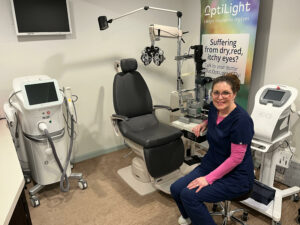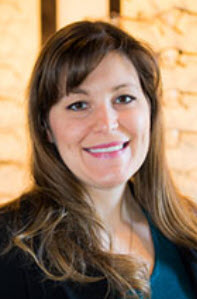
Dr. Richard in her dry eye treatment room. Dr. Richard says that there is a great opportunity at the current moment to expand and enhance services.
By Melissa Richard, OD
March 15, 2023
A long-term “new normal” appears to finally be here. This post-pandemic era comes with exciting opportunities to grow our practices. Focusing on ways to make the most of these opportunities has the potential to improve care and increase our per-patient revenue by at least $100 in the coming years.
Here are a few ways I am tapping into the moment we’re in to boost care while growing profitability.
Enhance Our Dry Eye/Blepharitis/MGD Solutions
Patients are returning to the office for comprehensive care and are complaining of dry eye symptoms. We’ve also been seeing more chalazia and meibomian gland issues since the start of the pandemic. It is thought that patients blink 80 percent less when staring at a screen…fewer blinks and more incomplete blinks. Understandably, now that most of our patients are using screens more than ever, dry eye is a growing problem.
We have been using a lifestyle index provided by Neurolens to survey our patients for vision-related symptoms, including dry eye. We started sending out the questionnaire electronically before the patient’s appointment. We review the results before they come in to the office, and if they are symptomatic for dry eye, we use our Marco Phoenix to do a tear break up analysis video as part of their comprehensive exam workup. This takes 1-2 minutes, and we can easily show the patient their results shortly afterwards.
If their results are abnormal, we print it out for the patient, and make recommendations for the initial treatment plan, which typically includes a three-step home dry eye regimen. We have a checklist sheet for the doctor to choose among a heat mask, a cleansing step and a lubrication step as recommended treatment options.
We mostly work with Optase products. We send the patient home with a dry eye treatment kit, and set up a follow-up for one month. At the follow-up, we repeat the break-up analysis. If it, and the patient’s symptoms, are 100 percent improved, they will continue on the Optase regimen. If only a slight improvement has occurred, I introduce our more advanced dry eye/MGD/blepharitis option. We offer low-level light therapy (LLLT), TearCare and OptiLight intense pulsed light (IPL) as our more advanced, out-of-pocket treatments. We keep an inventory of Optase products, which cost us $9-$12 per piece. We sell these products for $20-$25 each.
It takes our team an extra 1-2 minutes to run the testing during screening. It takes me an extra minute to explain the results to the patient, and then I send them to our office manager to review the products, make the sale and schedule a dry eye follow-up.
Before starting our dry eye treatment screening, we needed to make sure all staff was trained on using the Marco equipment and identifying patients who may qualify for the extra test.
Our investment and training effort has paid off, both for us and our patients, who receive a solution to their complaint. They don’t always bring up dry eye discomfort on their own, so the lifestyle index helps identify our patients who are suffering.
From a profitability perspective, we generate approximately $35 on their first month of dry eye treatment. If that works, they will be purchasing the products that are part of the treatment every 1-2 months. We also receive a dry eye follow-up, billed to medical insurance of about $65. Then, if they choose one of our advanced dry eye treatments, (we have about a 40 percent capture rate), we have the potential to generate $300-$1,000 depending on the option they choose. This is typically a yearly out-of-pocket expense to the patient.
Other Articles to Explore
Providing Solutions for Computer Vision Syndrome
Patients’ heavy screen usage means many have been suffering over the past 2-3 years with computer vision syndrome/digital eye fatigue, and are now willing to invest in relieving their symptoms.
We have been focusing on measuring more patients with the Neurolens measurement device, NMD2. The office manager or the doctor reviews the results of the lifestyle index. We then determine if they should be measured or remeasured. If time permits, we measure as many patients as possible. The more patients we measure, the more conversations we have. Even if we don’t convert the patient in the chair to purchasing Neurolenses, they inevitably know someone who may benefit from this technology. It’s a great opportunity for patient education and referrals.
Running the test takes approximately two minutes, and about one minute for the doctor to review and recommend.
Patients often experience life-changing improvements in their symptoms after getting help with their eye misalignment and binocular vision.
Increased sales of glasses that are not covered by insurance is a big profitability winner. We generate at least $600 profit on each sale of lenses and frames. We are currently selling 12-15 pairs per month in our small practice. Since the pandemic, we have doubled our previous sales. We also benefit from increased referrals, and the medical follow-ups for some of these patients.
We have been working with Neurolens for more than four years. The recent ability for our patients to fill out the lifestyle index before their appointment, and then get their measurement results sent directly to them, however, has improved our capture rate.
Building Our Cosmetic Services
Patients, including myself, have been on numerous video calls over the past three years. We stare at ourselves on the screen and notice all the things we would like to improve. This has brought many inquiries about Botox and fillers to our office.
For the last three years we have had an oculoplastic surgeon at our office one afternoon a week. We now do more advertising and special events to promote cosmetic options to enhance the appearance of our patients’ faces.
We split the costs and the profits with our oculoplastic surgeon. Our staff was trained to work with the surgeon to ensure patients are booked appropriately and given needed information before their arrival.
It’s exciting to be able to offer our routine patients these cosmetic benefits. There are frequent Botox commercials now on TV, and we’re seeing more patients driven to our office. They like being able to have this procedure in an office they are already familiar with and trust.
Per patient for Botox or fillers, we are generating $100-$400 per session. These patients return for additional Botox treatments every 3-4 months and for fillers annually or more often.
We can help patients be as happy with their appearance as they now are with how their eyes feel.
 Melissa Richard, OD, MS, is the owner of Spectrum Vision in Chalfont, Penn. To contact her: mrichard@spectrumvision.com
Melissa Richard, OD, MS, is the owner of Spectrum Vision in Chalfont, Penn. To contact her: mrichard@spectrumvision.com





















